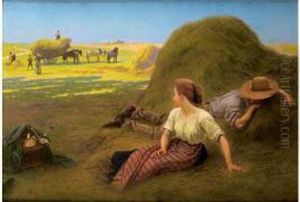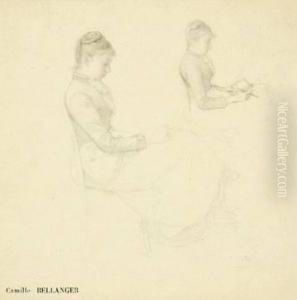Camille Felix Bellanger Paintings
Camille Felix Bellanger was a French painter born on April 24, 1853, in Paris. He was known for his genre paintings, historical scenes, and portraits. Bellanger entered the École des Beaux-Arts in Paris where he studied under Alexandre Cabanel, a celebrated academic painter of the time. He was a diligent student and quickly gained recognition for his talent.
Bellanger's style was deeply influenced by the academic tradition, and he was particularly adept at capturing the opulent atmosphere of the late 19th century in his works. This was a period in France known as the Belle Époque, characterized by a sense of optimism, economic prosperity, and cultural richness. His paintings often depicted scenes of bourgeois life, elegantly dressed figures, and historical narratives that appealed to the tastes of the time.
In 1875, Bellanger won the prestigious Prix de Rome with his painting 'The Death of Timophanes,' which allowed him to study at the Villa Medici in Rome. His time in Italy had a profound impact on his work, as he was exposed to the masterpieces of the Renaissance and the rich tapestry of Italian art history.
Bellanger frequently exhibited at the Paris Salon, the official art exhibition of the Académie des Beaux-Arts in Paris. He received several medals and honors for his work, including a third-class medal in 1879, a second-class medal in 1880, and a gold medal at the Exposition Universelle in 1889.
Over the course of his career, Bellanger also took on teaching roles, passing on his skills and knowledge to a new generation of artists. His commitment to the academic style persisted even as the art world began to shift towards Impressionism and Post-Impressionism.
Camille Felix Bellanger continued to paint until his death on March 24, 1923. While his name may not be as widely recognized today as some of his contemporaries, his work remains a testament to the academic art traditions of his time and provides a window into the cultural life of the Belle Époque in France.

















































